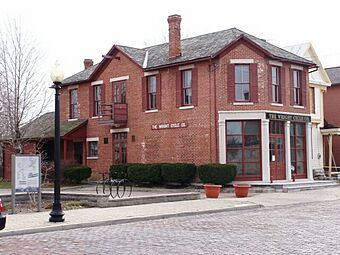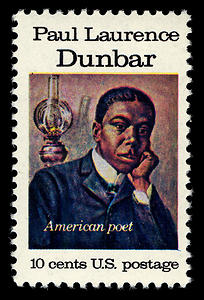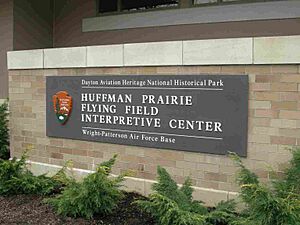Dayton Aviation Heritage National Historical Park facts for kids
|
Dayton Aviation Heritage National Historical Park
|
|

Wright Brothers Fourth Bicycle Shop, Dayton, Ohio
|
|
| Location | Montgomery and Greene counties, Ohio, U.S. |
|---|---|
| Nearest city | Dayton, Ohio |
| Area | 86 acres (35 ha) |
| Visitation | 73,588 (2015) |
| NRHP reference No. | 01000227 |
Quick facts for kids Significant dates |
|
| Added to NRHP | September 8, 1988 |
| Designated NHP | October 16, 1992 |
The Dayton Aviation Heritage National Historical Park is a special place in Dayton, Ohio. It's a National Historical Park that celebrates three amazing people. These are Wilbur Wright and Orville Wright, who invented the airplane, and Paul Laurence Dunbar, a famous poet. The park honors their important work and lives in the Miami Valley area.
Contents
Park History: Saving Important Places
The idea for this park started with a man named Jerry Sharkey. Many parts of Dayton where the Wright brothers lived and worked were being destroyed. Buildings were lost due to neglect, city changes, and new highways. Even one of the Wrights' bicycle shops was moved to Greenfield Village, Michigan, by Henry Ford many years ago.
Jerry Sharkey wanted to save what was left. He bought the last bicycle shop the Wright brothers owned in Dayton for a small amount of money. This saved the building from being torn down. He also started a group called Aviation Trail Inc. This group worked to create a national park or historic area for the Wright brothers' buildings.
Many people helped Jerry Sharkey. These included the Wright brothers' family, historians, judges, and local leaders. They all worked together to convince the government to create a new historic trail. This trail would connect all the important places related to the Wright brothers across the city.
In 1992, the U.S. Congress passed a law to create the park. President George H. W. Bush signed it into law. The new park not only protected the Wright brothers' sites but also the home of Paul Laurence Dunbar. Dunbar was a well-known African-American poet and a friend of the Wright brothers. Jerry Sharkey gave the bicycle shop he saved to the National Park Service as part of the park's creation.
A new visitor center opened in 2003. This was just in time for the 100th anniversary of the Wright brothers' first flight. Jerry Sharkey, the person who first dreamed of the park, passed away in April 2014.
Amazing People: The Wright Brothers and Paul Laurence Dunbar
The Wright Brothers: Pioneers of Flight
Wilbur and Orville Wright changed the world forever. They invented powered flight! In their bicycle shops in Dayton, Ohio, they taught themselves about aviation. They researched and built the very first machine that could fly with power, stay in the air, and be controlled. The Wrights also made their invention even better in 1904 and 1905. They did this at the Huffman Prairie Flying Field near Dayton.
Paul Laurence Dunbar: A Voice Through Poetry
Paul Laurence Dunbar became famous around the world for his writing. This was special because, at the time, it was hard for African Americans to get recognized in literature. He wrote novels, plays, short stories, songs, and over 400 poems. His work often showed the experiences of African American people in the United States. His writings helped people think more about social issues and cultural identity for African Americans. He died in 1906, but his words inspired later movements like the Harlem Renaissance and the early Civil Rights Movement. He was also a neighbor and friend to Wilbur and Orville Wright throughout their lives.
Explore the Park's Landmarks
The Dayton Aviation Heritage National Historical Park works with many groups to protect its sites. Here are some of the important places you can visit:
- The Wright Cycle Company Complex in Dayton. This includes the Wright Cycle Company building, where the brothers worked. It also has the Wright-Dunbar Interpretive Center and the Aviation Trail Visitor Center and Museum.
- Huffman Prairie Flying Field and its Interpretive Center. These are located inside Wright-Patterson Air Force Base near Fairborn, Ohio. The National Park Service runs them, and they are open to the public. This is where the Wrights perfected their flying machine.
- The Wright Company factory. This factory opened in 1910. It was the first place to build airplanes and teach people how to fly them.
- The Wright Brothers Aviation Center at Carillon Historical Park in Dayton. This center is managed by Dayton History.
- The Paul Laurence Dunbar State Memorial in Dayton. This is the home of the famous poet. Dayton History operates it for the Ohio History Connection.
- Hawthorn Hill. This was Orville Wright's home from 1914 to 1948. It is located in Oakwood, Ohio, just south of Dayton.
The Dayton Aviation Heritage National Historical Park is part of a larger area called the National Aviation Heritage Area. This area covers eight counties in Ohio and was created by Congress in 2004. The park's sites are a key part of this important aviation heritage area.
Images for kids
-
Hawthorn Hill, Orville Wright's home in Oakwood, Ohio
-
The Wright Flyer III, now in Carillon Historical Park, shown being flown by Orville Wright on October 4, 1905, over Huffman Prairie near Dayton
See Also
- Aviation Trail
- Wright Brothers National Memorial in Kitty Hawk, North Carolina













